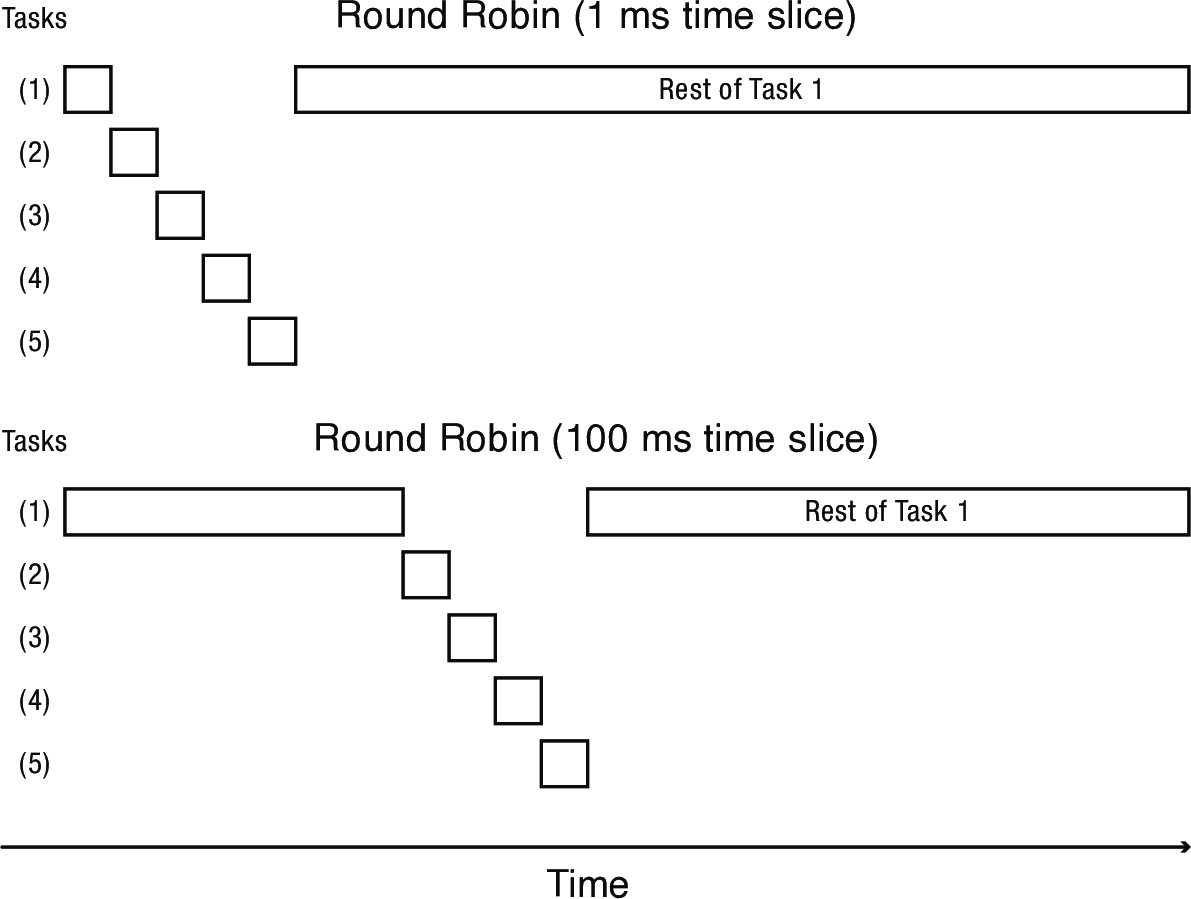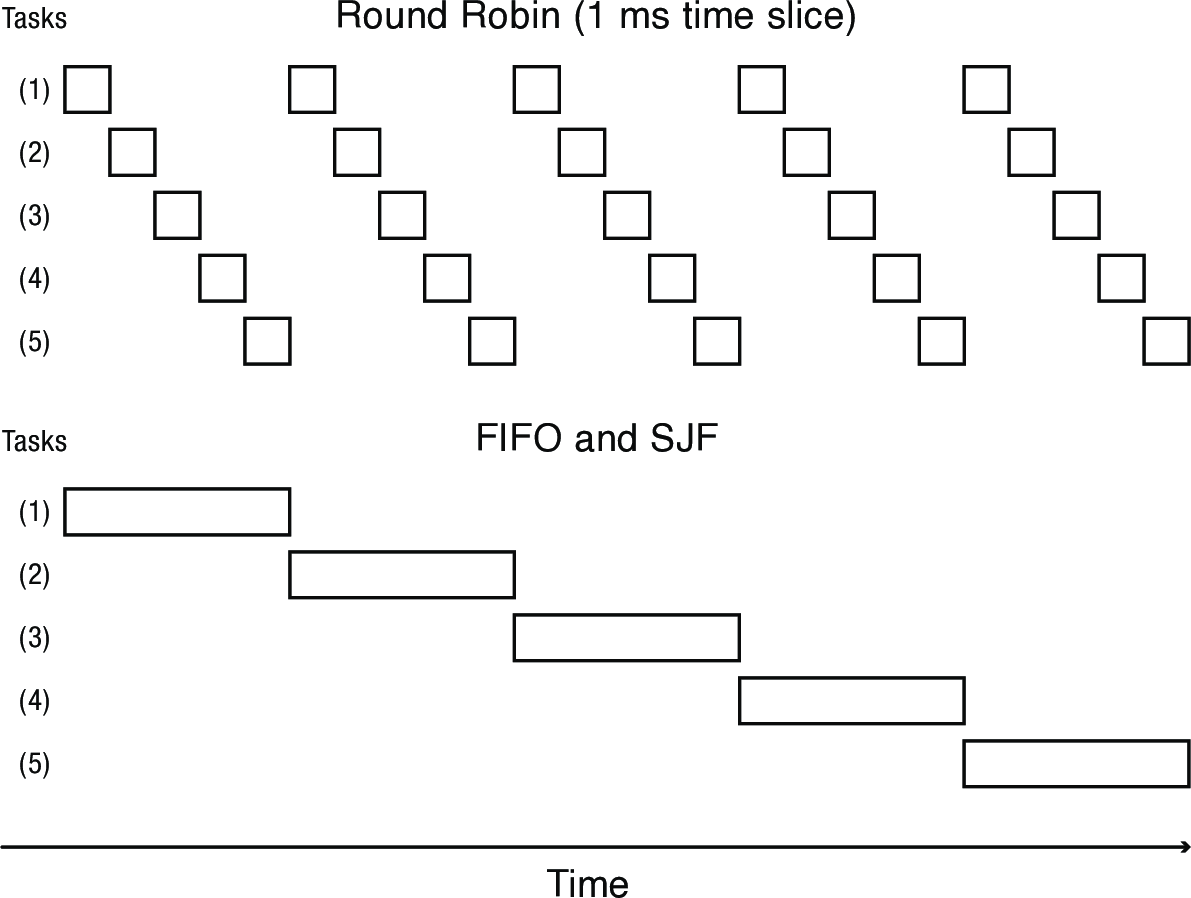CS 332 w22 — Uniprocessor Scheduling
Table of Contents
1 Overview
- Scheduling policy: what to do next, when there are multiple threads ready to run
- Or multiple packets to send, or web requests to serve, or …
- Definitions
- Response time, throughput, predictability
- Fundamentals: Unicore policies
- FIFO, SJF, round robin, max-min fairness
- Multilevel feedback queue as approximation to optimal
- Next time:
- Energy-aware scheduling
- Multicore policies
2 Definitions
- Workload
- Set of tasks (also called jobs) for system to perform
- Tasks can be any size, a thread or process can generate multiple tasks
- Tasks can be compute-bound or I/O bound
- Preemptive scheduler
- If we can take resources away from a running task
- Work-conserving
- Resource is used whenever there is a task to run
- For non-preemptive schedulers, work-conserving is not always better
- Scheduling algorithm
- Takes a workload as input, decides which tasks to do first
- Performance metrics (response time, predictability, throughput, overhead, fairness) as output
- Only preemptive, work-conserving schedulers to be considered
3 Performance Metrics
- Throughput
- Average tasks completed per time unit
- Response Time
- Average time required to complete a task
- Predictability
- Low variance in response times for repeated requests
- Fairness
- ???
- Unfairness
- Higher priority tasks get special treatment
4 Scheduling Policies
4.1 FIFO
- Schedule tasks in the order they arrive
- Continue running them until they complete or give up the processor
- Seems completely fair, right?
- If you've ever waited in line, this is how they tend to work
- On what workloads is FIFO particularly bad?
4.2 Shortest Job First (SJF)
- Always do the task that has the shortest (remaining) amount of work to do
- Often called Shortest Remaining Time First (SRTF)
- Suppose we have five tasks arrive one right after each other, but the first one is much longer than the others
- Which completes first in FIFO? Next?
- Which completes first in SJF? Next?

4.2.1 SJF is Optimal for Average Response Time
- Why?
- Interchange argument
- If a longer task precedes a shorter one in the schedule, swap them
- The longer one's response time in the new schedule equals the shorter one's in the old schedule
- The shorter one's response time in the new schedule is less than the longer one's in the old schedule
- So, the average response time has decreased
- Interchange argument
- Does SJF have any downsides?
- Fairness—should shorter tasks always go first?
- Starvation—what if a longer task never gets a turn?
- Worst for variance in response time (longer tasks scheduled as slowly as possible)
- Frequent context switches
- Requires knowledge of the future! (Have to approximate in practice)
4.3 Round Robin
- Each task gets resource for a fixed period of time (called a time slice or a time quantum)
- If task doesn't complete, it goes back in line
- Need to pick a time slice
- What if time slice is too long?
- Infinite? We're back to FIFO
- What if time quantum is too short?
- One instruction? Death by overhead
- What if time slice is too long?


4.4 Multi-Level Feedback Queue (MFQ)
- Goals:
- Responsiveness
- Low overhead
- Starvation freedom
- Some tasks are high/low priority
- Fairness (among equal priority tasks)
- Not optimal at any of them!
- Linux, Windows, and MacOS all use a form of MFQ scheduling
- Set of Round Robin queues
- Each queue has a separate priority
- High priority queues have short time slices
- Low priority queues have long time slices
- Scheduler picks first thread in highest priority queue
- Tasks start in highest priority queue
- If time slice expires, task drops one level

- Rule 1: If Priority(A) > Priority(B), A runs (B doesn't).
- Rule 2: If Priority(A) = Priority(B), A & B run in round-robin fashion using the time slice (quantum length) of the given queue.
- Rule 3: When a job enters the system, it is placed at the highest priority (the topmost queue).
- Rule 4: Once a job uses up its time allotment at a given level (regardless of how many times it has given up the CPU), its priority is reduced (i.e., it moves down one queue).
- Rule 5: After some time period S, move all the jobs in the system to the topmost queue.
5 Reading: Multi-level Feedback Queue
Read OSTEP chapter 8, (p. 85–94) on the multi-level feedback queues. It develops this classic scheduling technique in more detail.